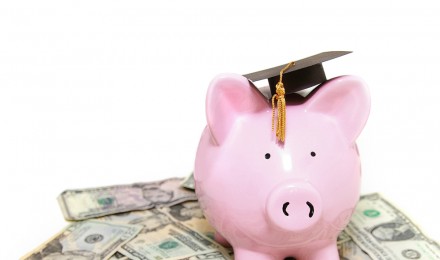The cost of attending college or receiving other forms of post-secondary provides a significant challenge for high school graduates, parents and policymakers. Although public institutions may receive funding in the form of federal and state appropriations, gifts and endowments, students and parents have the primary responsibility to pay for college or vocational training. Many students cover gaps in their financing by obtaining student loans.
So, just what is a student loan? The product designed to help students pay the cost of post-secondary education. Students rely on these loans to cover the following items:
- Tuition
- Books
- Room
- Board
- Fees
Compared to other loans, student loans may have substantially lower interest rates. Many borrowers choose to defer repayment while the student attends school.
Types of student loans
It is estimated that federal education loans originations exceed $100 billion annually. For the private student loan market originates about 10% of that amount or $10 billion each year.
The most common educational loans fall into in three categories:
Student loans – This product consist of the Federal Perkin and Federal Stafford loans, which have low interest rates. Students do not have to undergo credit checks or put up collateral. Student loan products offer a number of deferment options and extended repayment terms
Undergraduate students who can demonstrate financial need can apply for a Direct Subsidized Loans. Direct Unsubsidized Loans are made available to both undergraduate and graduate students, but do not require you to demonstrate financial need. The difference between the two products is that Direct Subsidized Loans have better terms.
Parent loans – This type of loan, usually called PLUS loans, enable the parents of dependent students to receive loan to help augment financial aid packages. The money can be used to cover and expense, including the full cost of attendance. PLUS loans do not have a cumulative limit and funds are provided through the Direct Loan program. Although some parents may give the student the responsibility to make loan payments parents are held responsible for the payments.
Private student loans– Private Education Loans or Alternative Education Loans can help you cover the gap between the actual cost of your education and the amount you can qualify to borrow from government programs. These loans are offered by private banks and do not require you to complete federal forms. However, borrowers may be subjected to credit reports.
Students/parents can also qualify for consolidation loans, which combine student loans and/or parent loans into a single loan. These loans are available for both federal and private loans. The U.S.Department of Education provides the funds for federal education loans—student loans and Federal Parent PLUS, through the Direct Loan program programs.
Student loan interest rates and fees
Congress determines the maximum interest rates and fees that lenders can charge students or parents for federally–guaranteed loans. The loans processed and disbursed through the institution’s financial aid office. Many of the loans have similar terms.
The Federal Direct PLUS loan has a higher interest rate of 7.9% compared to 3.4% – 6.8% for other federally-guaranteed loans.
The current fees for federal student loans are: 1 percent for Direct Subsidized Loans and Direct Unsubsidized Loans and 4 percent for Direct PLUS Loans. Perkins loans do not carry a fee. Fees are deducted from the loans when they are disbursed.
Loan payments
Similar to the process regarding any type of financial product, you should shop and compare. Some lenders offer lower fees or discounts to attract borrowers. While conducting your research to determine what a student loan is, you should be aware that similar to loans for cars and mortgages, student loans must be repaid– even if you incur a financial hardship.
Borrowers who want to save money and pay off their obligations sooner may want to pay new interest that accrues on the loan while in schools and during grace periods. Deferring student loan payments, which consist of principal and interest, can result in negative amortization—an increase in the principal amount owed on the loan.
The cost of attending college or receiving other forms of post-secondary provides a significant challenge for high school graduates, parents and policymakers. Although public institutions may receive funding in the form of federal and state appropriations, gifts and endowments, students and parents have the primary responsibility to pay for college or vocational training. Many students cover gaps in their financing by obtaining student loans.
So, just what is a student loan? The product designed to help students pay the cost of post-secondary education. Students rely on these loans to cover the following items:
- Tuition
- Books
- Room
- Board
- Fees
Compared to other loans, student loans may have substantially lower interest rates. Many borrowers choose to defer repayment while the student attends school.
Types of student loans
It is estimated that federal education loans originations exceed $100 billion annually. For the private student loan market originates about 10% of that amount or $10 billion each year.
The most common educational loans fall into in three categories:
Student loans – This product consist of the Federal Perkin and Federal Stafford loans, which have low interest rates. Students do not have to undergo credit checks or put up collateral. Student loan products offer a number of deferment options and extended repayment terms
Undergraduate students who can demonstrate financial need can apply for a Direct Subsidized Loans. Direct Unsubsidized Loans are made available to both undergraduate and graduate students, but do not require you to demonstrate financial need. The difference between the two products is that Direct Subsidized Loans have better terms.
Parent loans – This type of loan, usually called PLUS loans, enable the parents of dependent students to receive loan to help augment financial aid packages. The money can be used to cover and expense, including the full cost of attendance. PLUS loans do not have a cumulative limit and funds are provided through the Direct Loan program. Although some parents may give the student the responsibility to make loan payments parents are held responsible for the payments.
Private student loans– Private Education Loans or Alternative Education Loans can help you cover the gap between the actual cost of your education and the amount you can qualify to borrow from government programs. These loans are offered by private banks and do not require you to complete federal forms. However, borrowers may be subjected to credit reports.
Students/parents can also qualify for consolidation loans, which combine student loans and/or parent loans into a single loan. These loans are available for both federal and private loans. The U.S.Department of Education provides the funds for federal education loans—student loans and Federal Parent PLUS, through the Direct Loan program programs.
Student loan interest rates and fees
Congress determines the maximum interest rates and fees that lenders can charge students or parents for federally–guaranteed loans. The loans processed and disbursed through the institution’s financial aid office. Many of the loans have similar terms.
The Federal Direct PLUS loan has a higher interest rate of 7.9% compared to 3.4% – 6.8% for other federally-guaranteed loans.
The current fees for federal student loans are: 1 percent for Direct Subsidized Loans and Direct Unsubsidized Loans and 4 percent for Direct PLUS Loans. Perkins loans do not carry a fee. Fees are deducted from the loans when they are disbursed.
Loan payments
Similar to the process regarding any type of financial product, you should shop and compare. Some lenders offer lower fees or discounts to attract borrowers. While conducting your research to determine what a student loan is, you should be aware that similar to loans for cars and mortgages, student loans must be repaid– even if you incur a financial hardship.
Borrowers who want to save money and pay off their obligations sooner may want to pay new interest that accrues on the loan while in schools and during grace periods. Deferring student loan payments, which consist of principal and interest, can result in negative amortization—an increase in the principal amount owed on the loan.







